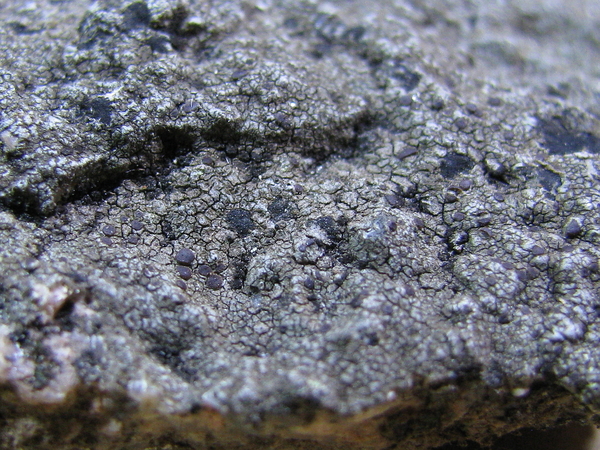Ramboldia petraeoides (C. Bab. & Mitt.) Kantvilas & Elix
Bryologist, 97: 298, 1994. Basionym: Lecidea petraeoides Nyl. ex C. Bab. & Mitt. in Hook. - Fl. Tasman., 2: 352, 1859.
Synonyms: Lecidea aspidula Kremp.; Lecidea myoplaca Zahlbr.; Lecidea subtenebrosa Nyl.; Protoparmelia petraeoides (C. Bab. & Mitt.) Hertel; Pyrrhospora petraeoides (C. Bab. & Mitt.) Hafellner
Distribution: C - Sar (Kantvilas & Elix 1994, Nöske 2000).
Description: Thallus crustose, episubstratic, verrucose-areolate, cream-coloured to dark brown, rarely delimited by a dark prothallus, the areoles 0.3-0.8(-1.5) mm (rarely up to 3 mm) wide. Cortex 10-20 µm thick, brown in upper part, with a 5-15 µm thick epinecral layer; medulla white, I-. Apothecia lecideine/biatorine, round to irregular in outline, subimmersed to sessile, not constricted at base, 0.5-0.8(-1.3) mm across, with a red-brown to dark brown, slightly glossy, flat to slightly convex disc and a thin, finally excluded, glossy proper margin. Proper exciple prosoplectenchymatous, of radiating, branched and anastomosing hyphae, 30-70 µm wide laterally, colourless to pale brown in outer part, the pigmented zone 10-20 µm wide, the inner part brown to colourless, K+ purple-red; epithecium brown or red-brown, 10-15 µm high; hymenium colourless, 35-55 µm high; paraphyses sparingly branched and anastomosing, c. 1.5 µm thick, the apical cells 2.5-3.5 µm wide; hypothecium colourless. Asci 8-spored, clavate, the tholus with a strongly amyloid lateral part, a non-amyloid broadly diverging axial mass with a thick, non-amyloid cap above, and a weakly amyloid outer layer Lecanora-type. Ascospores 1-celled, hyaline, ellipsoid-oblong, 8.5-11 x 3-5 µm. Pycnidia immersed. Conidia thread-like, 14-15.5 x c. 0.5 µm. Photobiont chlorococcoid, the cells 9-10(-12) µm wide. Spot tests: thallus K+ yellow turning red (needle-like crystals), C-, KC-, P+ yellow. Chemistry: norstictic and connorstictic acids.
Note: on siliceous rocks in exposed, dry situations; the collection from Sardinia is the only one known from the Northern Hemisphere.
Growth form: Crustose
Substrata: rocks
Photobiont: green algae other than Trentepohlia
Reproductive strategy: mainly sexual
Commonnes-rarity: (info)
Alpine belt: absent
Subalpine belt: absent
Oromediterranean belt: absent
Montane belt: extremely rare
Submediterranean belt: absent
Padanian area: absent
Humid submediterranean belt: absent
Humid mediterranean belt: absent
Dry mediterranean belt: absent

Predictive model
Growth form: Crustose
Substrata: rocks
Photobiont: green algae other than Trentepohlia
Reproductive strategy: mainly sexual
Commonnes-rarity: (info)
Alpine belt: absent
Subalpine belt: absent
Oromediterranean belt: absent
Montane belt: extremely rare
Submediterranean belt: absent
Padanian area: absent
Humid submediterranean belt: absent
Humid mediterranean belt: absent
Dry mediterranean belt: absent

Predictive model
 INDEX FUNGORUM
INDEX FUNGORUM
 GBIF
GBIF
 DOLICHENS
DOLICHENS


